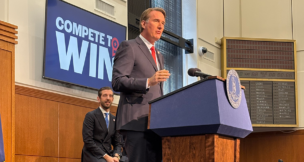Fed’s Fifth District expands slightly amid uncertainty
Modest increases in employment, wages, price growth

Image by AdobeStock

Image by AdobeStock
Fed’s Fifth District expands slightly amid uncertainty
Modest increases in employment, wages, price growth
SUMMARY:
- In recent weeks, Federal Reserve‘s Fifth District saw modest employment growth with mixed hiring plans, continued modest wage growth
- Latest Beige Book reports moderate year-over-year price growth expected to increase more quickly
- Cargo volumes surged due to frontloading to pre-empt tariffs; imports warehoused near ports
The economy in the Federal Reserve’s Fifth District — encompassing Virginia, Maryland, North Carolina, South Carolina, Washington, D.C., and most of West Virginia — continued to expand mildly in recent weeks, according to the latest edition of the Fed’s Beige Book, released Wednesday.
Published eight times per year, the Beige Book is based on anecdotal information about economic conditions gathered from the nation’s 12 Federal Reserve Banks. It is compiled from reports by Fed Bank and branch directors, as well as information gathered from business contacts, community organizations, economists, market experts and other sources. The June edition is an update from the Fed’s April 23 report.
Here’s what the most recent Beige Book edition revealed about the direction the regional economy is taking:
Employment increased slightly in the most recent reporting period. Business contacts had differing hiring plans based on their expectations. While a Maryland fast-casual restaurant decided to add locations, and therefore jobs, a different fast-casual restaurant in the Washington, D.C., region paused all hiring because of local economic uncertainty. A business consultant based in Richmond planned to reduce headcount by 20% because of declining revenues and uncertainty about future business.
Fed sources continued to report modest wage increases and pressure to raise wages more because of expected cost-of-living increases.
Despite rising input costs, year-over-year price growth in the Fifth District remained moderate, according to the Fed. Firms reported input costs rising at faster rates, and many business sources attributed the change to tariffs on materials they import. They also expected prices to increase more quickly over the next six months.
Manufacturers reported a slight increase in annual price growth. Non-manufacturers, though, reported a slight decrease. Survey respondents from both sectors saw prices grow in the 2.5-3% range.
Manufacturing activity declined modestly in this reporting period. Multiple Fed sources reported they adjusted their operations because of increased uncertainty. A multinational machine manufacturer, for example, shut down a domestic product line that sold internationally because of tariffs on exports.
Some manufacturers were surprised to see an uptick in new orders, including a cabinetmaker whose clients with office projects wanted to get ahead of tariffs and interest rate changes.
Cargo volumes in the Fifth District increased robustly, according to the Fed, and some ports had record import levels not seen since the post-COVID surge in fall 2023. Fed sources attributed the increase in imports to frontloading of goods from East Asian countries to preempt tariffs. Imports of automobiles and auto parts had notable upticks. Contacts from ports expected import volume to slow later this year because of the frontloading of goods.
Export volumes decreased moderately. Contacts attributed the decrease to tariffs imposed by other countries that shifted demand for U.S. agricultural products like timber, grain and soybeans.
Demand for bonded warehouse space shot up, with shippers seeking space to hold cargo near ports and wait out tariff changes. Trucking demand remained weak because companies were warehousing imports close to ports.
Consumer spending in the Fifth District increased slightly in the most recent reporting period. Most retailers saw steady to increasing sales, although the number of big ticket purchases declined. Hospitality companies also reported an overall increase in activity.
Contacts from both sectors noted consumers were opting for lower-priced alternatives. Conversely, some luxury retailers, hotels and experience providers had strong sales. Many retail and hospitality contacts expect sales to slow in the coming months due to declining consumer sentiment, potentially higher prices and heightened uncertainty.
Fifth District residential real estate flattened in past weeks. Inventory continued to increase, but buyer traffic decreased slightly. Homebuilders expressed frustration with “regulatory ‘red tape’” that adds to costs, as well as the uncertainty tariffs create on future prices for raw materials and home appliances.
Commercial real estate also flattened. Industrial space was most affected as companies tried to assess operating space, tariffs and whether to maintain a U.S. presence. Office space vacancy rates continued to decrease as companies returned to in-person work. The region had a slight uptick in office space upfits. One Virginia agent said government contractors have a motivation to upfit their offices for security reasons.
Financial institutions reported steady demand for most loan types and modest increases in demand for commercial real estate loans. Contacts described increases in demand for consumer real estate loans as seasonal but still at historical lows. Modest increases in delinquency rates continued, although rates are still at low levels overall. Deposit levels remained stable, and competition between institutions eased.
Nonfinancial service providers saw a slight increase in demand but were unsure how long it would last. Multiple consulting firms said they would either reduce staff or, at a minimum, maintain their current workforce until they and their clients have more economic certainty.
T
















